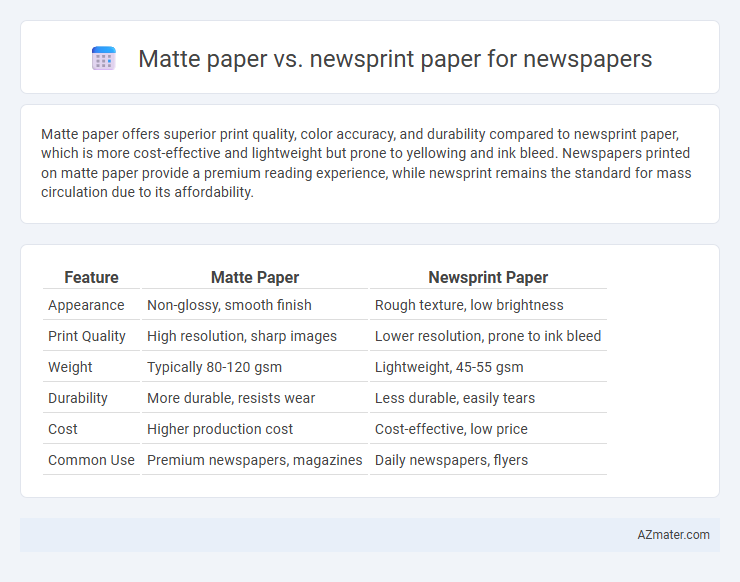Matte paper offers superior print quality, color accuracy, and durability compared to newsprint paper, which is more cost-effective and lightweight but prone to yellowing and ink bleed. Newspapers printed on matte paper provide a premium reading experience, while newsprint remains the standard for mass circulation due to its affordability.
Table of Comparison
| Feature | Matte Paper | Newsprint Paper |
|---|---|---|
| Appearance | Non-glossy, smooth finish | Rough texture, low brightness |
| Print Quality | High resolution, sharp images | Lower resolution, prone to ink bleed |
| Weight | Typically 80-120 gsm | Lightweight, 45-55 gsm |
| Durability | More durable, resists wear | Less durable, easily tears |
| Cost | Higher production cost | Cost-effective, low price |
| Common Use | Premium newspapers, magazines | Daily newspapers, flyers |
Introduction: Matte Paper vs Newsprint Paper
Matte paper and newsprint paper differ significantly in texture, quality, and durability, crucial factors for newspaper production. Matte paper offers a smooth, coated finish that enhances image clarity and color vibrancy, making it ideal for high-quality prints. Newsprint paper, characterized by its lightweight, uncoated, and porous nature, is cost-effective and traditional for mass newspaper circulation but often results in lower print sharpness and quicker degradation.
Understanding Matte Paper
Matte paper offers a smooth, non-glossy finish that enhances readability and reduces glare, making it ideal for newspapers that prioritize clear text and high-quality images. Unlike newsprint paper, which is inexpensive and lightweight but prone to yellowing and tearing, matte paper provides better durability and color reproduction for longer-lasting print materials. Choosing matte paper for newspapers improves the overall reader experience by delivering crisp graphics and a professional appearance without the shine of glossy finishes.
What is Newsprint Paper?
Newsprint paper is a low-cost, lightweight paper primarily made from wood pulp, designed specifically for printing newspapers due to its high absorbency and fast-drying properties. It offers a rough texture and matte finish that enhances print readability while being economical for mass production. Compared to matte paper, newsprint absorbs more ink and is less durable, making it ideal for short-term use in daily publications.
Print Quality Comparison
Matte paper offers superior print quality for newspapers due to its smooth surface, which enhances ink absorption and produces sharper, more vibrant images and text compared to newsprint paper. Newsprint paper, typically made from lower-quality wood pulp, has a rougher texture that can cause ink to spread and produce less crisp prints. While newsprint is more cost-effective and suitable for high-volume runs, matte paper significantly improves visual clarity and color richness in newspaper printing.
Color and Image Reproduction
Matte paper offers superior color vibrancy and sharper image reproduction compared to newsprint, making it ideal for high-quality newspaper visuals. Newsprint paper, being more porous and lower in brightness, tends to absorb ink and produce duller colors with less detail. Matte paper enhances contrast and minimizes glare, resulting in clearer and more appealing newspaper images.
Durability and Lifespan
Matte paper offers superior durability and a longer lifespan compared to newsprint paper, making it ideal for newspaper editions intended for extended reading or archival purposes. Newsprint paper is more prone to yellowing, tearing, and deterioration due to its lower quality fiber content and lack of protective coating. The enhanced coating and higher paper density of matte paper strongly resist moisture and handling damage, significantly extending the newspaper's usable life.
Cost Analysis: Matte vs Newsprint
Newsprint paper typically offers a lower cost per square foot compared to matte paper, making it the more economical choice for large-scale newspaper printing. Matte paper, while pricier, provides superior print quality and durability but significantly increases overall production expenses. Publishers must balance budget constraints with desired visual appeal and shelf life when choosing between matte and newsprint paper.
Environmental Impact and Sustainability
Matte paper is often coated and bleached, which increases chemical usage and energy consumption in production, leading to a higher environmental footprint compared to newsprint paper. Newsprint paper, typically made from recycled fibers and uncoated pulp, offers better recyclability and biodegradability, making it a more sustainable choice for newspapers. Choosing newsprint supports reduced deforestation and lowers pollution levels associated with paper manufacturing and disposal.
Reader Experience and Perception
Matte paper enhances reader experience by providing a smooth surface that reduces glare and improves text clarity, making prolonged reading more comfortable. Newsprint paper offers a lightweight, economical option but can cause ink bleed and lower image sharpness, potentially diminishing perceived quality. Readers tend to associate matte paper with higher-end publications due to its durability and visual appeal, whereas newsprint is often linked to mass distribution and limited longevity.
Choosing the Right Paper for Newspapers
Matte paper offers a smooth, non-glossy finish that enhances image clarity and vibrant color reproduction, making it ideal for high-quality newspaper printing. Newsprint paper is lightweight, cost-effective, and designed for short-term use, which suits mass circulation newspapers with frequent publication schedules. Choosing the right paper depends on balancing print quality, durability, and budget constraints specific to the newspaper's target audience and distribution frequency.

Infographic: Matte paper vs Newsprint paper for Newspaper
 azmater.com
azmater.com